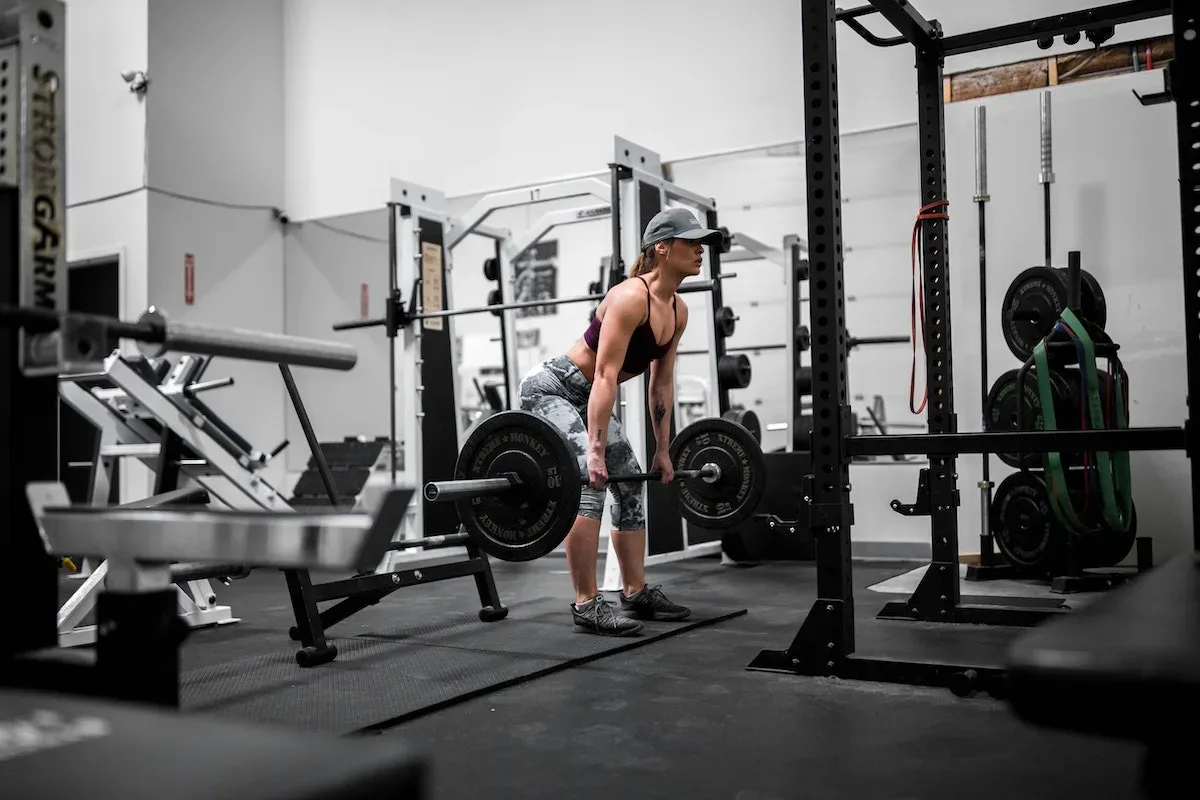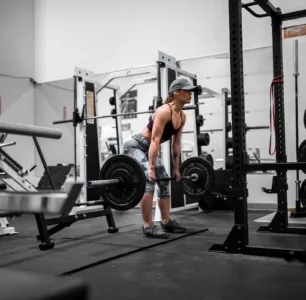Deadlifts are often considered the king of all exercises, and for good reason. They work multiple muscle groups, increase strength, and promote overall health. In this ultimate guide to deadlifts, we explore everything you need to know about this powerful exercise.
The Basics of Deadlifts
Deadlifts are a compound exercise that works the hamstrings, glutes, lower back, upper back, and forearms. It involves picking up a barbell from the ground and standing up with it. Deadlifts can be broken down into four parts: setup, pull, lockout, and descent.
Setup
To begin the deadlift, set the barbell on the floor with your feet shoulder-width apart. The barbell should be positioned over the middle of your feet. Bend down and grip the bar with both hands, keeping your palms facing down. Your hands should be outside of your knees. Keep your back straight and your chest up, and lift your hips to lower your shoulders down to the bar.
Pull
To initiate the pull, push your feet through the ground while keeping your back straight. Lift the barbell up while keeping it close to your shins. The bar should come up straight and close to your body. Once the bar clears your knees, drive your hips forward to complete the lift.
Lockout
Once the barbell is at the top of the lift, stand up straight with your hips fully extended and your shoulders back. You should be squeezing your glutes and tightening your core. Hold this position for a moment before beginning the descent.
Descent
To descend, lower the barbell back down to the floor by bending your hips and knees. Keep the barbell close to your body as you lower it. Once the bar touches the floor, reset and prepare for the next repetition.
Variations of Deadlifts
There are several variations of the deadlift that can target different muscle groups and increase strength. Some of the most common variations include:
- Sumo Deadlift: This variation involves a wider stance and a narrower grip on the bar. It targets the inner thigh and glutes.
- Romanian Deadlift: This variation involves keeping your legs straight while lowering the barbell to your mid-shin level. It targets the hamstrings and glutes.
- Trap Bar Deadlift: This variation involves using a special bar that has handles on the side. It puts less strain on the lower back and targets the quads and glutes.
- Single-Leg Deadlift: This variation involves standing on one leg while holding a weight in one hand. It targets the hamstrings and glutes on one side of the body.
Benefits of Deadlifts
Deadlifts are one of the most effective exercises you can perform. Not only do they work multiple muscle groups, but they also provide a host of benefits for your body and overall health. Here are some of the top benefits of deadlifts:
Increased Strength
Deadlifts are a compound exercise that work multiple muscle groups, including the hamstrings, glutes, lower back, upper back, and forearms. By performing deadlifts regularly, you can increase your overall strength and build muscle mass.
Improved Posture
Deadlifts are a great way to improve your posture. By strengthening your back muscles, you can help to prevent back pain and improve your overall posture. This can also lead to improved athletic performance and reduced risk of injury.
Increased Bone Density
Resistance training, such as deadlifts, has been shown to increase bone density. This is important for reducing the risk of osteoporosis and other bone-related conditions.
Improved Grip Strength
Deadlifts require a strong grip, which can help to improve your overall grip strength. This can also translate to improved performance in other exercises that require grip strength, such as pull-ups or rows.
Increased Metabolic Rate
Deadlifts are a highly intense exercise that can help to increase your metabolic rate. This means that you’ll burn more calories even when you’re not working out, which can help with weight loss and weight management.
Improved Cardiovascular Health
Deadlifts are a highly intense exercise that can also provide cardiovascular benefits. By increasing your heart rate and improving your oxygen uptake, deadlifts can help to improve your cardiovascular health.
Increased Hormonal Response
Deadlifts have been shown to increase the body’s production of testosterone, growth hormone, and other hormones that are important for muscle growth and overall health.
Deadlifts are one of the most effective exercises you can perform. They work multiple muscle groups, increase strength, and promote overall health. By adding deadlifts to your workout routine, you can experience a host of benefits for your body and overall health. Just be sure to use proper form and technique to avoid injury.
Deadlift variations
Deadlifts are one of the most effective exercises you can perform, but did you know there are several variations of the deadlift that can target different muscle groups and increase strength? Here are some of the most common variations of deadlifts:
Sumo Deadlift
The Sumo Deadlift involves a wider stance and a narrower grip on the bar. This variation targets the inner thigh and glutes more than the conventional deadlift. To perform the Sumo Deadlift, place your feet wider than shoulder-width apart and turn your toes out slightly. Grip the bar with your hands inside your legs, and then lift the barbell up while keeping it close to your shins.
Romanian Deadlift
The Romanian Deadlift involves keeping your legs straight while lowering the barbell to your mid-shin level. This variation targets the hamstrings and glutes more than the conventional deadlift. To perform the Romanian Deadlift, stand with your feet hip-width apart, grip the bar with your hands outside your legs, and then lower the bar down while keeping your legs straight.
Trap Bar Deadlift
The Trap Bar Deadlift involves using a special bar that has handles on the side. This variation puts less strain on the lower back and targets the quads and glutes more than the conventional deadlift. To perform the Trap Bar Deadlift, stand in the centre of the bar with your feet hip-width apart, grip the handles with your hands, and then lift the barbell up while keeping it close to your body.
Single-Leg Deadlift
The Single-Leg Deadlift involves standing on one leg while holding a weight in one hand. This variation targets the hamstrings and glutes on one side of the body. To perform the Single-Leg Deadlift, stand on one leg, hold a weight in one hand, and then lower the weight down while keeping your back straight.
Stiff-Legged Deadlift
The Stiff-Legged Deadlift involves keeping your legs straight throughout the exercise. This variation targets the hamstrings and glutes more than the conventional deadlift. To perform the Stiff-Legged Deadlift, stand with your feet hip-width apart, grip the bar with your hands outside your legs, and then lower the bar down while keeping your legs straight.
Muscles worked by deadlifts
Deadlifts are one of the most effective exercises for working multiple muscle groups in the body. Here are the muscles that are primarily worked by deadlifts:
Hamstrings
The hamstrings are the muscles on the back of the thigh, and they are heavily targeted by deadlifts. The hamstrings work to extend the hips and bend the knees during the lifting phase of the deadlift.
Glutes
The glutes are the muscles in the buttocks, and they are also heavily targeted by deadlifts. The glutes work to extend the hips during the lifting phase of the deadlift.
Lower Back
The lower back muscles are also heavily targeted by deadlifts. These muscles work to keep the back straight during the lift and prevent injury.
Upper Back
The upper back muscles, including the traps and lats, are also worked during deadlifts. These muscles work to stabilise the upper body during the lift.
Quadriceps
The quadriceps are the muscles on the front of the thigh, and they are worked to a lesser extent during deadlifts. The quads work to extend the knee during the lifting phase of the deadlift.
Forearms
The forearms are also worked during deadlifts, as they are responsible for gripping the bar and holding on to it during the lift.
Overall, deadlifts are a highly effective exercise for targeting multiple muscle groups in the body. By working these muscles, you can increase your overall strength, build muscle mass, and improve your overall health and fitness. Just be sure to use proper form and technique to avoid injury.
Risks of deadlifts
While deadlifts are one of the most effective exercises for building overall strength and muscle mass, they also come with a number of risks. Here are some of the main risks associated with deadlifts:
Back Injury
Deadlifts put a lot of stress on the lower back, and if performed incorrectly, they can lead to back injuries. Common injuries include strains, sprains, and herniated discs. To avoid back injuries, it is important to use proper form and technique when performing deadlifts.
Knee Injury
Deadlifts can also put stress on the knees, particularly if the knees are not aligned properly during the lift. This can lead to injuries such as knee strains, sprains, and tears. To avoid knee injuries, it is important to keep your knees aligned with your feet and to avoid locking them out during the lift.
Grip Injury
Deadlifts require a strong grip, and if your grip is not strong enough, you may be at risk for grip injuries. These can include blisters, calluses, and even torn skin. To avoid grip injuries, it is important to use proper grip technique and to build up your grip strength gradually over time.
Cardiovascular Stress
Deadlifts are a highly intense exercise, and they can put a lot of stress on the cardiovascular system. If you have an underlying cardiovascular condition, such as high blood pressure or heart disease, you may be at increased risk for cardiovascular complications during deadlifts. It is important to speak with your doctor before starting any new exercise program, particularly if you have a pre-existing medical condition.
Overtraining
Deadlifts are a highly intense exercise, and if you perform them too frequently or with too much weight, you may be at risk for overtraining. Overtraining can lead to muscle strains, fatigue, and even injury. It is important to give your body enough time to rest and recover between workouts.
While deadlifts can be a highly effective exercise for building overall strength and muscle mass, they also come with a number of risks. To avoid injury, it is important to use proper form and technique, build up your strength gradually over time, and give your body enough time to rest and recover between workouts. As with any exercise program, it is important to speak with your doctor before starting any new routine, particularly if you have a pre-existing medical condition.
Are deadlifts good exercise for rugby players
Yes, deadlifts are an excellent exercise for rugby players. Rugby is a physically demanding sport that requires a lot of strength, power, and endurance. Deadlifts are a compound exercise that work multiple muscle groups, including the hamstrings, glutes, lower back, upper back, and forearms. By performing deadlifts regularly, rugby players can increase their overall strength and power, which can translate to improved performance on the field.
In addition to building strength and power, deadlifts can also help to improve posture and reduce the risk of back injuries, which are common in rugby players. Deadlifts can also help to increase bone density and improve cardiovascular health, both of which are important for overall health and fitness.
That being said, it is important to use proper form and technique when performing deadlifts, particularly when lifting heavy weights. Rugby players should work with a qualified trainer or coach to ensure they are using proper form and to build up their strength gradually over time. It is also important to give the body enough time to rest and recover between workouts to avoid overtraining and injuries.

